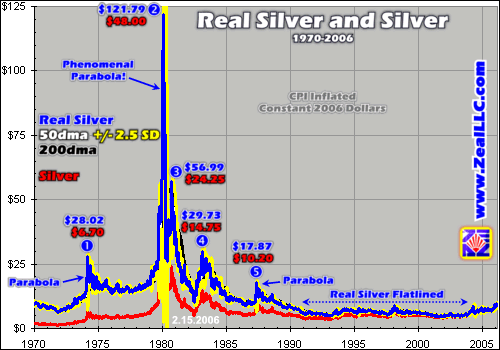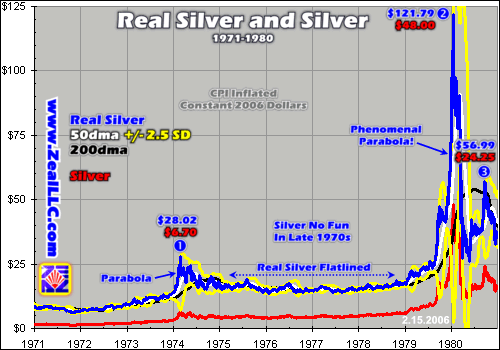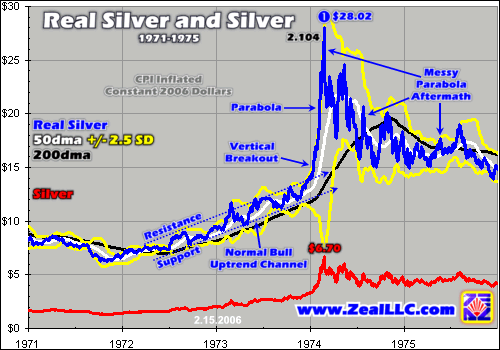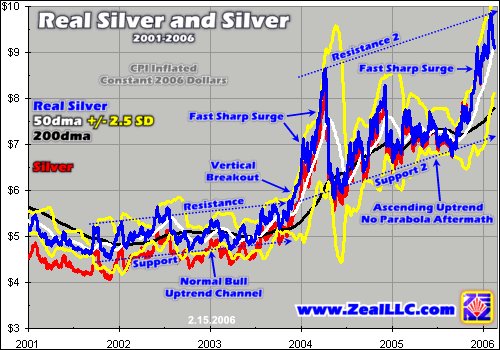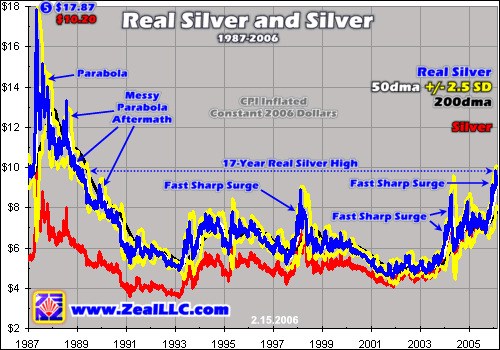|
|
|||||||
|
|
|
|
|
|
|
|
|
|
Real Silver Highs Adam Hamilton February 17, 2006 3447 Words
Five weeks ago I penned an essay detailing 35 years of gold prices in real inflation-adjusted terms. At the time the financial media was trumpeting 25-year gold highs in order to scare investors away from gold. But in the real terms that truly matter, gold was only trading near early 1990s levels which are quite low in historic context.
Perspective is everything in the financial markets. Comparing multiple decades of prices in nominal terms without considering the enormous impact of inflating US money supplies leads to perilous perspective distortions. Distorted strategic perspectives then lead to poor decision making which greatly reduces the odds that investors will be successful in multiplying their capital.
Investors cannot hope to buy low and sell high over the long term without an understanding of what real low and high prices are once adjusted for relentless fiat-dollar inflation. This timeless truth applies to all financial markets, including real estate, stock markets, and commodities markets. The longer a particular investment is held, the more important it becomes to consider its price in true real terms.
After my recent essay on real gold highs was published, I started to get deluged with requests to undertake a similar study on silver. This was a great idea and I really appreciate all you who wrote in to suggest it. As a lifelong student of the markets and huge fan of silver myself, an inflation-adjusted silver analysis sounded fascinating so here it is.
I used the same methodologies in this silver study as I used in my earlier gold study, so if you would like more background information please see ďReal Gold Highs?Ē. Basically daily closing silver prices since 1970 are inflated into constant 2006 dollars using the US Consumer Price Index as an inflation proxy. This is pretty conservative since the CPI is lowballed for political reasons and true monetary inflation far exceeds CPI growth.
For comparability purposes I created five silver charts that match the date ranges of the five gold charts from my earlier essay. Our first chart, encompassing this entire real silver dataset, highlights the most breathtaking parabolic blowoff that you and I are ever likely to see in any financial market.
The first question burning a hole in every silver investorís mind is just how high did silver rocket in 1980 in todayís dollars? Its January 21st, 1980 all-time closing high of $48 translates into just under $122 today! Obviously this is vastly higher than anything we have seen in 25 years and it highlights just how low silverís price is today in real terms trading under $10. This metal remains very cheap in its young bull market.
The most striking aspect of this chart has to be the parabolic nature of silver. This metal has long had a reputation for extreme volatility and lightning-fast gains when capital floods into it and this is confirmed abundantly in real terms. At least three of the five greatest real silver moves in the last several decades are full-on vertical parabolas, where most of silverís gains for a particular bull run accrued rapidly in its final days.
Such parabolic rallies certainly pose challenges for investors and speculators. If you are not already long silver and a parabola ignites, there is no point in even trying to chase it. It can shoot higher and then crash back down quicker than a shooting star and only those pre-deployed are going to catch it. With little or no warning before silver roars vertically, silver investors must always maintain silver exposure for a shot at these legendary runs.
And once a parabolic vertical blowoff launches, it can either multiply or fail at any time. This makes it absolutely essential in silver-related trades, probably more so than in any other major market, to have prudent trailing stop losses in place. As you examine the blistering speed and wicked brutality of post-parabola silver collapses in these charts, realize that automatic mechanical sell stops are probably the only way you will get out quick enough in a collapse to realize most of your gains.
Even without the phenomenal parabola in late 1979 that witnessed real silver rocket from under $25 to nearly $125 in just 5 spectacular months, real silver levels were generally much higher in the 1970s and 1980s than what weíve seen in recent years. The metal generally ran from $15 to $25 in todayís dollars for over a decade during the last Great Commodities Bull. Sub-$10 silver today remains really low.
And as I discussed in my real gold essay, this straight-up comparison is really conservative because the money supplies have grown far faster than CPI inflation or silver mining. On top of this, global silver stockpiles have dwindled from enormous levels decades ago to just 1/5th those levels today. So when speculators ignite the next silver mania there will be relatively vastly more dollars chasing relatively far less silver. Due to pure monetary considerations alone another silver mania could temporarily drive the metal well above $125 in the years ahead!
Another interesting aspect of this strategic chart is real silver prices have been largely flatlined for the better part of 15 years now. Despite the young bull market in silver and the great gains that have already been won in trading elite leveraged silver stocks, silverís new bull remains so tiny that it has barely even registered visually yet. Silver will not even get interesting in real terms until it once again trades over $25, about 175% higher than todayís levels!
Our next chart zooms into the last great silver bull in the 1970s. Viewed in todayís dollars it offers a great deal of insights into what investors and speculators might expect in the years ahead in terms of raw volatility and potential gains. Just like today, even back then silver investing was defined by long periods of boredom punctuated by wickedly fast parabolic spikes that earned fortunes for those blessed enough to ride them.
In todayís dollars silverís amazing 1970s super bull was born at $6.22 in November 1971. It topped at $121.79 real in January 1980 for an unbelievably immense 1858% real gain. Real gold gains over roughly the same time frame ran about 1100% for comparison. With a much smaller market that is easily pushed around by abnormal speculative capital inflows, the raw potential for silver in our current bull still remains much greater than goldís.
While this is the good news, the bad news is the nature of silverís bull markets. The vast majority of silverís 19.6x multiplication during the 1970s occurred in just the last months of its bull market. Other than a brief mini-parabola in 1974, real silver couldnít sustain levels over $25 until late 1979. In a magnificent bull market that lasted about 98 months, all the really exciting gains only occurred in its final 5 months. Patience is essential for long-term silver investing!
From the November 1971 lows until real silver first crossed $25 for good in late August 1979, about 93 months, the metal was only up about 4x at best. But from August 1979 until January 1980, silver rocketed from $25 to nearly $125, adding another 15.6x to its ultimate gains. Stated in another way, 80% of the entire real gains in silver during the 1970s happened in just the last 5% of its bull market! 50% of its entire gains occurred in just the last 17 trading days, or less than 1% of this bull!
The ramifications of the nature of this last silver super bull are pretty sobering. We have all heard silver promoters hype the metalís great potential by talking about its 1970s gains. While these statements about silver are absolutely true, without the context of a chart like this one I suspect most investors would automatically assume that silverís gains were more linear. That they would accrue gradually over time and not virtually all occur in just the waning months of a major bull.
The reality of the 1970s silver super bull was an initial period of nice gains in the early 1970s and then an excruciating 66-month sideways grind before the silver bull could resume its progress interrupted at its February 1974 highs. All the while many other commodities were resolutely marching higher as they ought to in a Great Commodities Bull, leaving silver behind. Six-and-a-half years is a long, long time to keep the faith without any confirmation from silver.
Now there is certainly no rule that our current silver bull will have to mirror its previous behavior in the 1970s. As a matter of fact I expect it not to for a variety of reasons. The top three in my mind have to do with information flow, trading ease, and stockpiles. But nevertheless, silver investors need to have the patience of Job to weather the long boring periods between the mighty parabolas that can make them rich in mere months. If you are not patient, silver is probably not the game for you.
Thankfully our current bull ought to play out much differently than the last big one. The 1970s was well before the Information Age so there was not only a much smaller pool of investors but less ways for people with excess capital to become knowledgeable about the commodities bull. Today every investor with an Internet connection, which effectively means every investor period, can easily learn about the vast opportunities in commodities. This should broaden and deepen silver participation this time around.
Today it is also vastly easier to trade silver than several decades ago. Futures accounts have become much less cumbersome and some can even be traded online like stock accounts. In addition the coming silver ETF really should lead to a flood of stock capital into silver just as the gold ETF is shunting stock demand into physical gold.
Faster information flow and easier trading should yield a silver bull that rises in a more normal fashion than the 1970s, much more linear and less parabolic. This is because these developments increase the ratio of investors to speculators, and buy-and-hold investors are a moderating influence on extreme volatility.
And in the 1970s global above-ground silver stockpiles were vast, running between 2.0b to 2.5b ounces. Thus it was possible to dip into these inventories during the 66 months in the late 1970s when the silver price flatlined. Indeed over 0.5b ounces of silver stockpiles were released on the market during that period which kept its price in line despite rising demand. Today total global stockpiles are already believed to be under 0.5b ounces so there is a far smaller buffer to absorb marginal investment demand now.
Thus I believe the odds are in favor of silver rising in a much more agreeable fashion this time around with its gains spread out over its entire secular bull more evenly. While I do still expect a parabolic blowoff at the end of this bull since this is silverís nature, perhaps this time around only 50% of silverís total gains will accrue in the last few months of its bull instead of 80%. This will make it much easier on silver investorsí patience.
Perhaps the most relevant point of comparison for todayís young silver bull is with the early years of the 1970s. There are encouraging similarities and differences between what happened three decades ago and what we are witnessing today. This also offers some insights into what kind of real silver levels investors might be able to expect early on in our current bull market.
After bottoming in November 1971, real silver started climbing higher in a nice normal bull-market uptrend channel that ran for a couple years. During this textbook-perfect young bull silver started at $6.22 real and didnít decisively break out of its uptrend until about $14 real in early 1974. Thus silver investors were blessed with awesome 125% real gains over 25 months, which is an ideal linear ascent.
But in early 1974 the immense volatility for which silver has been so famous for centuries reasserted itself with a vengeance. The metal rocketed from $14 to $28 real in a blink of an eye, just two months. From late 1971 to early 1974 silver ran 4.5x higher in its initial bull-market upleg, but fully 50% of these gains happened during the early 1974 parabola in just the last 7% or so of this first-phase silver bull.
Now this is all well and good. Silver investors had ample time to go long silver in the early 1970s when it was rising nicely without facing the risk of being whipsawed out. It was quite logical to be heavily invested in silver in light of its solid 25-month uptrend before the 1974 parabola broke out vertically. The problem with parabolic gains in this case is not catching them, but dealing with their messy aftermath.
Whenever any price rises vertically on a long-term chart, its move is virtually always unsustainable. Over long periods of time it is fundamental supply and demand imbalances that drive prices higher, and it is almost impossible for global supply and demand to change radically and irreversibly enough to justify a commodity price doubling in mere months. Thus these parabolas are driven by speculative capital and not fundamentals.
Once a parabola ignites and a price doubles or more in short order, speculators soon realize that such lofty price levels are not fundamentally justified and they start selling. This selling leads to the characteristic crashes that follow parabolas. And after the crash is the messy, ugly sideways grind that makes profitable trading difficult. This pattern is very common in any market that endures a major parabolic ascent. Witness the NASDAQ bubble, burst, and bust of the last half decade.
So parabolas usually cause big problems for investors. Investors get really excited when the parabola launches and then really morose when it just as rapidly crashes. Their faith in the bull market is tested and as they reach their tolerance limits they gradually sell out which creates uninspiring price action for potential new investors waiting from the sidelines.
Personally I would much rather see bulls climb in a somewhat orderly fashion instead of rocketing and then crashing. The ultimate height and gains a bull achieves are directly correlated to the number of investors and the amount of capital deployed in it. Orderly bulls entice in more capital over the long run and lead to higher highs than disorderly bulls vacillating between euphoria and horror as parabolas swell and burst. Prematurely damaged confidence is never good for bull-market longevity and strength.
If too many investors are scared away too early in a bull by extreme volatility, the bull is never nurtured properly and never grows to its full potential. Thankfully todayís silver bull has barely avoided 1970s-style parabolic behavior so far. We see some fast sharp surges, but no truly vertical parabolas and their ugly aftermaths.
While I understand that the distinction between a truly vertical parabola and a fast sharp surge can seem nitpickingly subtle, it is very real nevertheless. In our current bull we have seen two or three fast sharp surges depending on how you divide them, a couple in late 2003/early 2004 and another in just the recent months. If you carefully examine these events they grew close to going vertical but they thankfully never quite pulled it off.
In the first fast sharp surges of this bull in 2003/2004, silver broke out of its normal bull uptrend channel just as it had exactly three decades earlier. But instead of doubling over the next two months, silverís fast ascent was significantly less radical. In real terms it gained about 50% between its December 2003 breakout and its April 2004 top, a bit over 3 months. This is far less extreme than a 100% gain in just 2 months.
Since silver really didnít go parabolic at least by its own historic standards, its early 2004 correction, while sharp and vicious, didnít last long. Silver bottomed just one month after its April 2004 top and then resolutely started marching higher again in a new ascending uptrend. While there is no doubt that this spooked investors at the time, as I discussed in late April 2004, it wasnít a true parabola by historic silver standards so its aftermath was mild.
Recall above that after the 1974 parabola silver prices ground lower for years, not weeks, as they tried to reestablish equilibrium with global supply and demand as well as investment inflows. The faster and higher a parabola shoots, the more time it takes to work out all its price disruptions through the system. An orderly bull market is far easier to successfully invest and speculate in than one racked by periodic parabolic blowoffs and their ugly grinding aftermaths.
Now this is not to say that silver canít go parabolic today. It certainly could at any time. Markets are a probabilities game and silverís historic behavior runs heavily towards parabolic proclivities. But so far, regardless of the reasons, we have been very blessed to have a more or less orderly bull market at least by silver standards. This is the type of orderly bull that gets new investors interested in silver so they can add their own capital to the mix and ultimately drive silver much higher.
Finally I would like to close with a chart that is going to become really important once silver breaks $10.20 nominal in the coming year. At that point the financial media is going to boldly declare that silver is at 23-year highs and hence dangerously overbought, the same Machiavellian stratagem it tried on gold a month ago. But once again ignoring inflation is ridiculous and real silver levels wonít be anywhere close to extreme.
In todayís dollars silver is currently near a 17-year high, which is certainly not a trivial event. But in order to exceed the real levels attained in its 1987 parabola, silver will have to approach $18. This is about a double from todayís silver prices and I canít wait for it to happen. But $18 silver is a great deal higher than the $10.20 nominal that the financial media will foolishly use to declare silver prices above 1987ís spike high. Be aware of this truth once $10.20 falls and the silly perilously-high-silver hysteria starts fomenting.
In light of this real silver study, silver really isnít going to get exciting in historic terms until its gets over $25. And believe me, it will get there sooner or later. There is no other market in the world that is as unique as silver. Not only is the silver market small relative to most other commodities markets and hence able to make breathtaking surges from time to time, but it is a speculatorís dream. I donít know of any other major commodities where so much capital can chase such a small market so fast to drive moonshots.
On top of the awe-inspiring speculative fervor silver periodically kindles, it is a very important industrial metal. Silver is used in all kinds of unique industrial applications where it is indispensable. And since the amount of silver in each finished product is usually small, silver consumers are largely not price sensitive. They will continue buying industrial silver regardless of its price. In addition most silver mined today is as a byproduct from other metals mining, so its supply canít be rapidly increased in response to rising prices. And global silver stockpiles are dwindling rapidly.
When you combine a small market, inelastic demand, inelastic supply, and huge amounts of investment and speculative capital always eagerly circling and wanting to dive in, the potential in silver is really vast. At Zeal we have been leveraging this entire silver bull by investing in and speculating in elite silver stocks. In this latest upleg since last autumn our realized gains on silver stocks deployed last year have run as high as 82%.
While it looks like silver may be a bit overbought at the moment and entering one of its periodic corrections here, we are already researching elite silver stocks in which to deploy capital at the next high-probability-for-success buying opportunity. Please subscribe today to our acclaimed monthly newsletter if you want to join us in actively riding this awesome young silver bull.
The bottom line is silver remains very inexpensive today in the real inflation-adjusted terms that matter. In light of historic precedent silver could easily climb above $25 for years and even has the potential to exceed $125 briefly when another popular speculative mania ignites in this volatile metal and drives it parabolic for a season. Prudent investors and speculators along for the ride will likely earn fortunes.
Adam Hamilton, CPA February 17, 2006 Subscribe |
|||||||
|
|
|
|
|
|
|
|
|
|
|
|
|
|
|
|||

